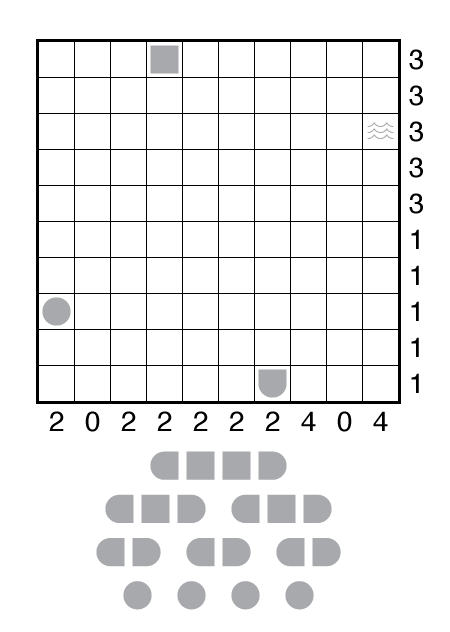Battleships by Thomas Snyder

or solve online (using our beta test of Penpa-Edit tools; use tab to alternate between ship placement and shading modes. In ship placement mode, right click gives sea, left click gives circle/square, left click and drag for rounded ships.)
Theme: Unbalanced
Author/Opus: This is the 165th puzzle from Thomas Snyder, aka Dr. Sudoku.
Rules: Standard Battleships rules. Use the indicated fleet.
Answer String: For each row from top to bottom, enter the number of the first column from the left where a ship segment appears (enter both digits if a two-digit number). If the row is empty, enter 0. Enter these numbers as a single string with no separators.
Time Standards (highlight to view): Grandmaster = 1:15, Master = 1:30, Expert = 3:00
Solution: PDF
Note: Follow this link for other classic Battleships. If you are new to this puzzle type, here are our easiest Battleships to get started on.

7:29
Ha, I did this puzzle in Paint, and filling in the given ship segments made me lose the end/middle distinction, causing me to believe there were two possible solutions for a while (not to mention making the solving path a lot harder).
This enjoyable puzzle can be solved easily using a technique borrowed from Constraint Satisfaction Programming (CSP) called “shaving”. It means improving the tentative solution by small, simple steps until the puzzle falls to a major rule or strategy (see Constraint Programming Models for Solitaire Battleships by Barbara M. Smith for a nice explanation).
Here’s the use of a shaving rule that easily leads to solving this puzzle. Following is the critical position after filling in simple segments and water:
1
1 2 3 4 5 6 7 8 9 0
+---------------------
A | _ _ L M R _ _ _ _ _ 3
B | O _ _ _ _ _ _ T _ O 3
C | _ _ . . . . _ M _ _ 3
D | _ _ . . . . _ M _ . 3
E | _ _ . . . . _ B _ * 3
F | _ _ _ _ _ _ _ _ _ * 1
G | _ _ . . . . _ _ _ . 1
H | O _ _ _ _ _ _ _ _ _ 1
I | _ _ _ _ _ _ T _ _ _ 1
J | _ _ _ _ _ _ B _ _ _ 1
2 0 2 2 2 2 2 4 0 4
The shaving rule we’ll use is one that can be called the “fan-out” rule. You can see it clearly by examining square D4: if D4 is a ship segment, it “fans out” and inserts three water in C3, C4, and C5 (because column 4 has only one remaining ship segment to be found). Waters in C3, C4, and C5 “close off” row C, i.e., there aren’t enough squares left for the remaining ship segments. Therefore D4 is water.
The same shaving rule can be applied to D5: a segment here means waters in C4, C5, and C6, which closes off row C. Therefore D5 is water.
That’s all we need to place the two remaining destroyers (2-segment ships): because we’ve filled D4 and D5 with water, the destroyers can be placed in one way only, in C3-C4 and D6-E6. The rest is simple.
Shaving can be a life saver with many Battleship puzzles and belongs in your solving tool kit. The fan-out rule can often be used to fill in many squares with water, thereby simplifying the tentative solution and setting us up for a more powerful rule.
01:54. Nicely constructed; that ending was interesting.